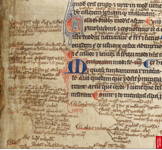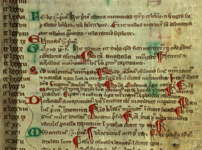Medica quaedam
at the
British Library (Harley MS 3140)
A beautiful collection of medical texts sometimes known as the Articella. It was the most popular medical textbook of the late Middle Ages.

Could this to be the former door to Malmesbury's famous medieval library? No, it is not. It is a blocked up doorway on the south wall of Malmesbury Abbey. However, the door to this most prestigious ancient library would have been very close nearby. The library was part of the Benedictine monastery founded by Aldhelm around 676. William of Malmesbury (c.1090 -c.1143) was its best known librarian.
The library is gone now but some books still survive. Historians have always attempted to list the contents of the library and have wondered if Aldhelm's books would have been seen by William.
We do know the location of some of the surviving books. A list of 29 known surviving manuscripts from Malmesbury Abbey comes from a Bodleian Library Oxford project called Medieval Libraries of Great Britain. Six of these documents have already been digitised in their entirety and can be seen on the web. Here are some details of those six.
at the
A beautiful collection of medical texts sometimes known as the Articella. It was the most popular medical textbook of the late Middle Ages.

at
A history of the world written by a monk of Malmesbury in the 1360s. It is a vital source for the history of Malmesbury and contains an eyewitness account of the Black Death. The Trinity manuscript is the original master copy (the autograph copy)of the book written by the hand of the author in Malmesbury.


at
A late Anglo-Saxon text is illustrated with beautiful line drawings. It contains a curse threatening damnation to anyone who removes the book from Aldhelm’s library at Malmesbury. The curse is the only proof that this book was in the Malmesbury Library.
The oldest known surviving document from the Malmesbury Library. The document combines a late 9th century manuscript and a 12th century manuscript of the works of the late Roman philosopher, MC. It was used extensively by William of Malmesbury and includes comments in his own handwriting.
View Martianus Capella as it is in Cambridge. Click animation to make the pages appear to turn.
at
This 11th century copy of the work of Gregory the Great was produced on the continent. It contains notes by William of Malmesbury and there is a good chance that it was obtaimed for the abbey by William himself. A later monk has inscribed the manuscript: Iste liber est de monasterio Malmesburye et in custodia ffratris Thome, that is, This book is from the monastery of Malmesbury and is in the care of Brother Thomas.
https://parkerweb.stanford.edu/parker/actions/page_turner.do?ms_no=361at
This 14th century document contains the monastic psalms, a calendar of feasts and the Litany of All Saints. It clearly comes from Malmesbury because Aldhelm gets pride of place in both the list of feasts and the litany. At some point it was obtained by the great Swiss Benedictine monastery of St Gallen.
http://www.e-codices.unifr.ch/en/csg/0026
A list of 29 known surviving manuscripts from Malmesbury Abbey comes from a Bodleian Library Oxford project called Medieval Libraries of Great Britain. The list of the Malmesbury documents is at the following web page:
http://mlgb3.bodleian.ox.ac.uk/mlgb/?search_term=Malmesbury&field_to_search=medieval_library&page_size=500&order_by=provenance_location_shelfmark&output_style=treeview